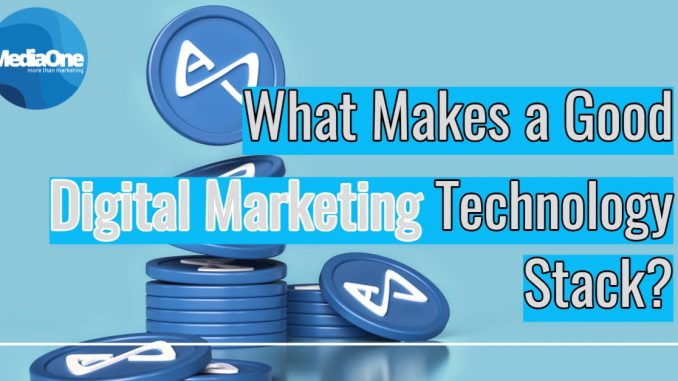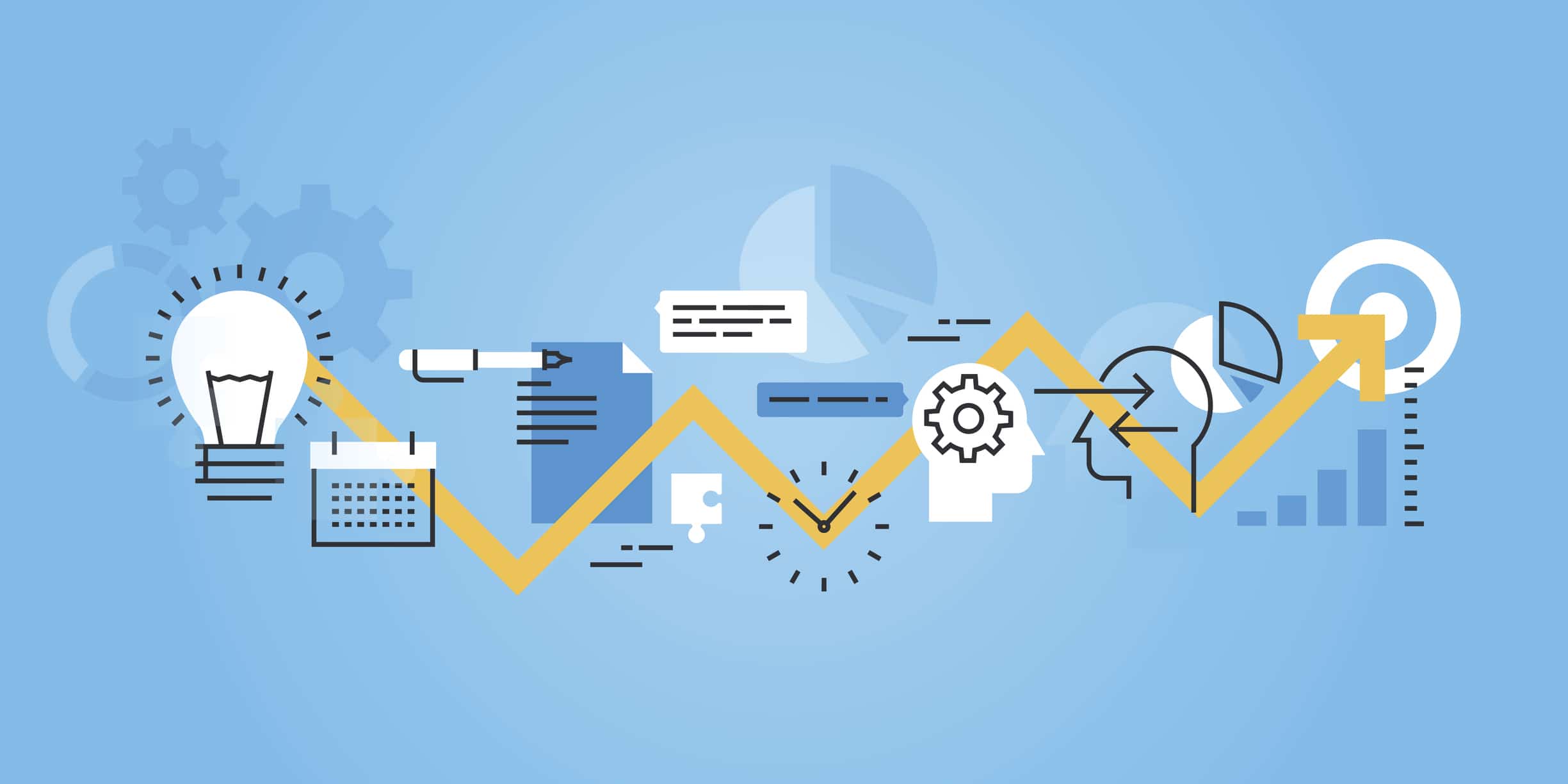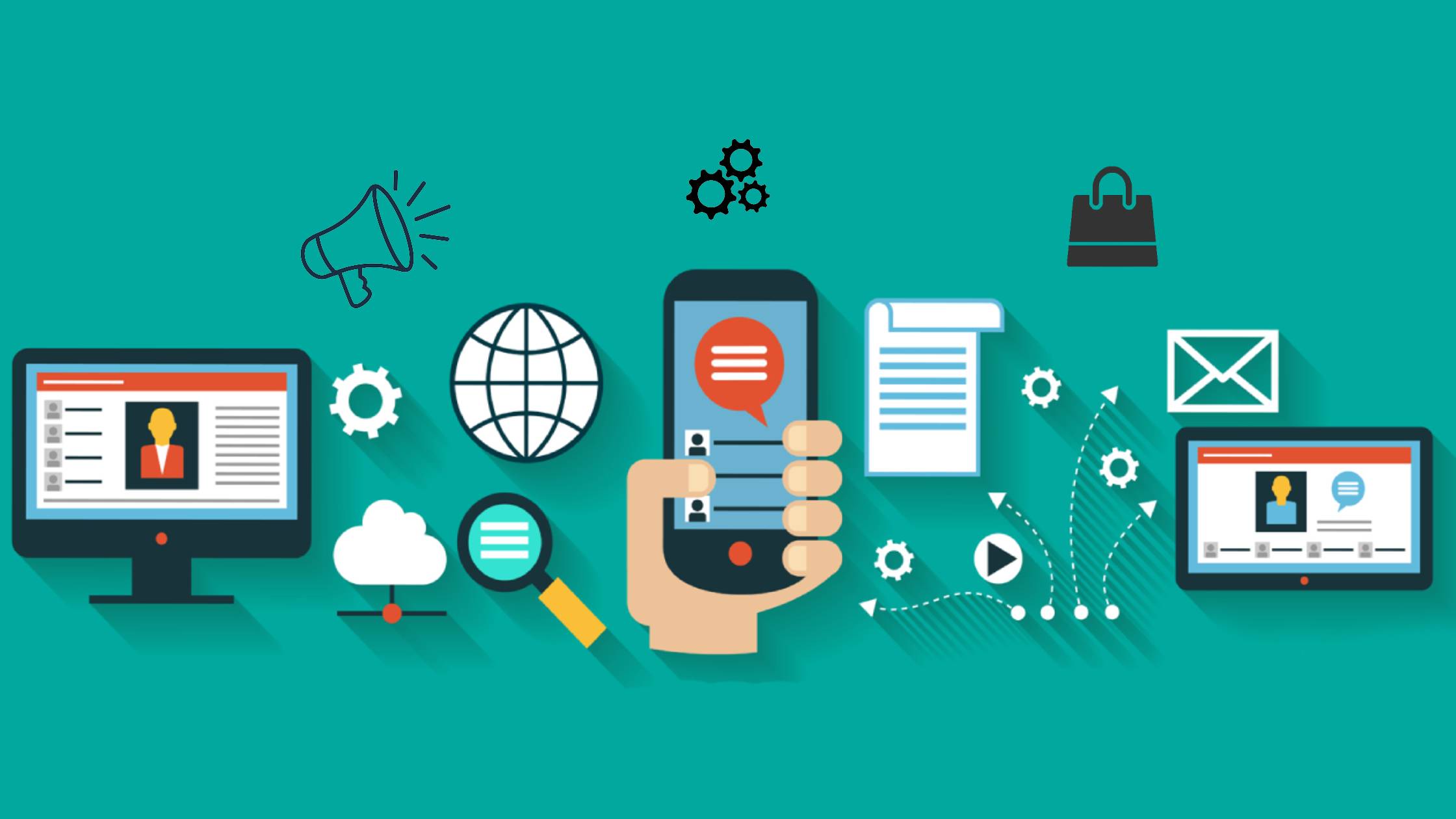
Marketing and technology go together like peanut butter and jelly (if you’re not a fan of PB&J, like coffee and doughnuts).
In other words, it’s damn near impossible for marketers to pull off a successful digital marketing campaign without adopting the right tools and technologies.
Marketing and tech are a perfect duo, naturally paired to get your message in front of the right people at the right time while helping you close more deals.
But how do you get the two to play nice together?
Simple, build a digital marketing technology stack that fits your business like a glove.
What’s Digital Marketing Technology Stack?
A digital marketing technology stack is a collection of software applications that work together to help you execute your digital marketing strategy. It’s the combination of tools, platforms, and services you can use to manage your digital marketing campaigns from start to finish.
A “good” digital marketing technology stack will help you automate tasks, understand your customers better, personalise your marketing efforts, and track your progress.
Here are a few examples of digital marketing technologies you might find in a stack:
- Website building and hosting platforms
- Email marketing software
- Content management systems
- Customer relationship management (CRM) software
- Analytics and reporting tools
- Advertising platforms
- SEO tools
- Collaboration tools
- Social media management tools
- Project management tools
#1. Customer Relationship Management (CRM) Software: CRMs are mainly used by B2B-ers. They’re a powerful way to track customer relationships, manage leads, and close deals.
Ultimately, CRMs are essential to gaining in-depth insights into how your marketing efforts impact your sales pipeline and bottom line.
Tools to Explore: Salesforce, HubSpot Sales CRM, SugarCRM, Pipedrive
#2. Marketing Automation Software: Marketing automation is a category of software that helps marketers automate repetitive tasks, like email marketing, social media posting, and targeted ads.
Marketing automation can free up your time, allowing you to focus on more strategic tasks, like creating content or developing new product offerings.
Tools to Explore: HubSpot Marketing, Marketo, Pardot, Act-On
#3. Content Management Systems (CMS): A good CMS is an absolute must for most digital marketers. A CMS powers your website, landing page, blog, and other digital properties.
It allows you to create, publish, and manage your content in one place. That makes it easier to keep your website up-to-date and ensure a consistent brand experience for your visitors.
Tools to Explore: HubSpot COS, WordPress, Joomla, Drupal, Sitecore
#4. Analytics and Reporting Tools: Analytics and reporting tools help you track your progress, understand what’s working, and identify the areas to improve.
Without these tools, it would be nearly impossible to measure the ROI of your digital marketing campaigns and optimise your efforts.
Tools to Explore: Google Analytics, Adobe Analytics, Heap, Mix panel
#5. Social Media Management Tools: Social media management tools help you publish content, track your performance, and engage with your audience on social media.
Tools to Explore: Hootsuite, Sprout Social, Buffer, CoSchedule
#6 SEO Tools: SEO tools help you track your site’s performance in search engines, optimise your content, and find new opportunities to improve your ranking.
Tools to Explore: Google Search Console, Moz, Ahrefs, SEMrush
#7 Project Management Tools: Project management tools help keep your digital marketing initiatives on track and ensure everything runs smoothly.
They’re especially helpful if you have a large team or complex campaigns.
Tools to Explore: Asana, Trello, Basecamp, Monday.com, Wrike
#8. Advertising Platforms: Advertising platforms help you buy and manage your paid advertising campaigns, like Google Ads or Facebook Ads.
Tools to Explore: Google Ads, Microsoft Advertising, Amazon Advertising, The Trade Desk
#9. Email Marketing Software: Email marketing is a cost-effective way to support sales, gain trust with your customer base, build brand awareness, and increase customer loyalty.
Email marketing capabilities might be readily available on other platforms in your stack, like your CRM or marketing automation software.
Tools to Explore: HubSpot Email Marketing, Constant Contact, Mailchimp, AWeber
#10. Website Building and Hosting Platforms: Your website is the foundation of your digital marketing efforts.
You want to choose a platform that’s easy to use, offers robust features, and can be customised to fit your specific needs.
Tools to Explore: HubSpot Websites, WordPress, Squarespace, Wix
#11. Collaboration and Productivity Tools: Collaboration and productivity tools help you and your team stay organised, on track, and focused on your goals.
They’re essential for remote teams or distributed organisations.
Tools to Explore: Google G Suite, Microsoft Office 365, Slack, Zoom
#12. Video Tools: Video marketing is a powerful way to connect with your audience, build trust, and increase engagement.
Tools to Explore: Wistia, Vimeo, YouTube
A digital marketing technology stack refers to the set of tools that marketers use to plan, execute, and measure their digital marketing campaigns.
A well-rounded digital marketing technology stack will have solutions for every marketing funnel stage, from top-of-the-funnel awareness to post-purchase customer retention and loyalty.
At a minimum, your digital marketing technology stack should include the following solutions:
Awareness: Advertising Platforms, SEO Tools, Social Media Management Tools
Consideration: Content Management Systems (CMS), Analytics and Reporting Tools, Project Management Tools
Conversion: Website Building and Hosting Platforms, Email Marketing Software, Collaboration, and Productivity Tools
Retention: Customer Relationship Management (CRM) Software, Loyalty Programs, Data Management Platforms (DMP)
Why Do You Need a Digital Marketing Technology Stack?
To create a holistic, integrated, and effective digital marketing strategy, you must have a technology stack that supports your efforts at every stage of your marketing funnel.
A digital marketing technology stack is an integral part of your digital marketing strategy for the following reasons:
It Helps You Stay Organised: A digital marketing technology stack helps you keep your digital marketing initiatives organised and on track.
It’s especially helpful if you have a large team or complex campaigns.
It Amplifies Your Efforts: A digital marketing technology stack amplifies your efforts by allowing you to automate repetitive tasks, personalise your messages, and scale your campaigns.
It Improves Efficiency: A digital marketing technology stack improves efficiency by helping you track your performance, optimise your campaigns, and identify areas that need improvement.
It Drives Results: Result-driven digital marketing requires best-in-class tools and technologies.
A digital marketing technology stack ensures you have the right tools to drive results.
5 Things to Consider When Building Your Digital Marketing Technology Stack
, only 9% of digital marketers have a fully integrated digital marketing technology stack.
Even with so many available options, many marketers still struggle with where to start. As digital marketing evolves, marketing tools become even more granular and specialised.
One digital marketing tool could solve three or more problems in the past.
Now, there are entire companies dedicated to solving one specific problem.
The sheer number of options can be overwhelming, but don’t let that stop you from building a technology stack that supports your digital marketing efforts.
Here are five things to keep in mind when building your digital marketing technology stack:
#1. Do I Have “Shiny Object Syndrome”?
Try avoiding the shiny object syndrome when building your digital marketing technology stack.
Shiny object syndrome is the tendency to chase after the latest and greatest shiny object without stopping to consider whether or not it’s actually a good fit for your business.
Before you add a new tool to your stack, ask yourself the following questions:
- Does this tool solve a specific problem that I’m facing?
- Will this tool help me achieve my marketing goals?
- Do I have the budget to support this tool?
- Do I have the staffing to implement and use this tool effectively?
If you can’t answer these questions with a resounding “yes,” it’s probably not worth investing your time or money in the tool.
#2. Does this Tool Integrate with the Other Tools in My Stack?
Another important consideration when building your digital marketing technology stack is whether or not the tools you’re using will play nice with each other.
Before adding a new tool to your stack, find out if it integrates with the other tools you’re using.
If it doesn’t, you’ll likely end up with a bunch of disconnected tools that don’t work together to form a cohesive whole.
#3. What are the Limitations of this Tool?
No tool is perfect, and it’s important to be aware of the limitations of each tool before you add it to your digital marketing technology stack.
Before you invest in a new tool, find out its limitations.
That way, you can decide whether or not the tool is a good fit for your needs.
#4. What Kind of Support does this Tool Offer?
Before investing in a new tool, find out what kind of support it offers.
Does the company offer 24/7 support? Do they have a robust knowledge base? What about email support?
The level of support offered by a company can be a make-or-break factor when choosing a new tool for your digital marketing technology stack.
#5. What is the Total Cost of Ownership?
When building your digital marketing technology stack, it’s also important to consider the total cost of ownership (TCO).
The TCO of a tool is more than just the initial purchase price.
It also includes training, implementation, support, and upgrade costs.
Before adding a new tool to your stack, you want to ensure that you understand the TCO clearly.
Only then can you decide whether the tool is worth the investment.
Digital marketing is a complex process with a lot of moving parts.
A well-built digital marketing technology stack can help you keep all those moving parts organised, working together to achieve your marketing goals.
When building your stack, you want to avoid shiny object syndrome, choose tools that integrate well with each other, and consider the TCO of each tool.
Real-time Examples of Digital Marketing Technology Stack
Digita Marketing Stack for Selling T-shirts Online
Let’s say you want to start selling T-shirts online.
First, you’ll need to design a website using a website-building platform like WordPress, Wix, or Squarespace.
Or you might need an e-commerce platform like Shopify to help you manage your inventory and process payments.
You may also need a web analytics tool like Google Analytics to help you track your website traffic and understand your customer’s behaviour.
And don’t forget that when you have so many scripts and plugins running on your website, you might need to run a tag manager tool like Google Tag Manager to keep everything organised.
Not to forget, you need a CRM system to manage your customer relationships and an email marketing platform to send automated emails and newsletters.
Phew! You need a lot of tools just to get started with selling T-shirts online.
A digital marketing stack can be incredibly simple as the example above or more complex depending on your business needs.
You have to identify your business requirements and define the goals of your stack — and, most importantly, how they correspond to your overall business strategy.
Now, let’s look at three real-world examples of digital marketing technology stacks that businesses use today.
#1. The New York Times
The New York Times is one of the most popular news websites globally
Their website runs on WordPress and uses Chartbeat to track its web traffic in real-time.
They also use Google Analytics and Parse.ly for website analytics and a tool called Outbrain for content discovery and native advertising.
They use Oracle Bluekai for segmentation., LivePerson for Live chat, and Google Ads and Twitter ads for their ads campaign.
#2. Airbnb
Airbnb is a popular vacation rental platform with
Their website and they use a tool called New Relic to help them track their website’s performance.
They also use Mixpanel for analytics and Mailchimp for email marketing.
They use slack for communication and Asana for project management.
Not to mention Twilio for SMS notifications, Heroku for hosting, Amazon S3 for file storage, and Google Analytics for website analytics.
For CRM, they use a tool called Intercom.
#3. Lyft
Lyft is a popular ridesharing platform with over 30 million users.
Their website is built on Node.js, and they use a tool called New Relic to help track their website’s performance.
They also use Mixpanel for analytics and Mailchimp for email marketing.
For communication, they use Slack, and for project management, they use Asana.
Last but not least, they also use Google Analytics for website analytics and Intercom for CRM.
As you can see, there is no one-size-fits-all digital marketing technology stack.
It all depends on your business requirements and goals.
Now that you know what goes into a digital marketing stack, it’s time to build your own.
A Digital Marketing Technology Stack For a Mid to Large-Sized SaaS Company
While this may look like an overwhelming task, it’s a highly effective and efficient stack when set up and used correctly.
The first step is to identify your business goals.
Do you want to increase brand awareness? Drive more traffic to your website? Convert more leads into customers?
Once you’ve defined your goals, you can start putting together your stack.
First, You’ll Need a website
As mentioned before, your website is one of the key pillars of your digital marketing strategy.
It’s the foundation that everything else is built on. You must ensure it’s well-designed, easy to use, optimised for conversion, and, most importantly, provides a great user experience.
Come to think of it. Your website is the first touchpoint that potential customers interact with — it doesn’t matter what you’re selling; if your website is a total mess, you will have a hard time convincing people to buy from you.
Add the other puzzle pieces once you’ve erected a shiny website.
Here’s a theoretical stack I have created:
A Tag manager
Having a website is only one part of the equation.
It would help if you also ensured the right people were seeing it.
To do that, you’ll need to add many third-party tags and tracking scripts to your website.
And, unless you want to spend your days manually adding and updating those tags, you’ll need a tag manager.
A tag manager is a tool that allows you to easily add, remove, and manage all the tags on your website in one place.
The two most popular tag managers are Google Tag Manager and Tealium IQ.
Customer Data Platform Plus Data Enrichment
Smaller companies can skip this step, but if you’re a mid to large-sized company, you’ll need a customer data platform (CDP).
A CDP is critical to maintaining clean databases. It’s how you ensure all the marketing tools and platforms in your stack can send and receive data from each other without any errors or reduced quality.
A CDP also solves the problem of poorly made integrations between disparate data systems, ensuring they’re all connected to one centralised source of customer data.
In short, a CDP gives you a 360-degree view of your customers. It organises incoming customer data from different sources, allowing other technologies to access it in a single platform.
This way, you have all the information you need about your customers in one place and can make better-informed decisions about your marketing campaigns.
Many CDPs are on the market, but some of the most popular ones are Segment, mParticle, and BlueConic.
Data Enrichment
The information you collect may be incomplete or inaccurate.
That’s why you need data enrichment.
Data enrichment is the process of using business intelligence and public data sources to fill in the gaps in your customer data.
It’s where you ensure the information you have is complete and accurate.
Many data enrichment providers are on the market, but some of the most popular ones are , FullContact, and LeadEnrich.
Customer Relationship Management (CRM)
A CRM is a tool that helps you manage your customer relationships.
Ah yes, the customer — the reason we’re doing all this in the first place.
A CRM is a software solution dedicated to storing customer data, including their contact information, purchase history, and, most importantly, their interactions with your brand.
But a CRM is more than just a database. It’s also a tool that helps nurture your relationships with your customers and turn them into lifelong fans.
Some popular CRMs are Salesforce, HubSpot, and Zoho.
Web Analytics
At this point, you might be thinking, “I don’t need all this data. I just want to know how many people are visiting my website.”
And that’s a valid concern.
But trust me, you need web analytics.
Web analytics analyses your website data to understand how your visitors interact with your website.
It’s how web admins get to know how many people visited their website from search engines within the past seven days. What’s the average number of pages each user visits? How long do they stay on each page?
And most importantly, what actions are they taking on your website?
Are they subscribing to your newsletter? Are they filling out your contact form? Are they buying your product?
Examples of web analytics tools are Google Analytics, Mixpanel, and Heap.
Marketing Automation
Now that you have all this data, what will you do with it?
The answer is simple: marketing automation.
Marketing automation is the process of using technology to automate marketing tasks.
It’s how you take all the manual marketing tasks, such as sending emails and creating social media posts and turn them into automated processes.
This way, you can focus on the bigger picture while your marketing automation tool takes care of the nitty-gritty.
Some popular marketing automation tools are HubSpot, Marketo, and Pardot.
Email Marketing
Email marketing is the process of sending out emails to your customers and prospects.
It’s one of the most effective ways to connect with your audience, build relationships, and drive conversions.
And it’s a key component of any digital marketing technology stack.
Some popular email marketing platforms are Mailchimp, Constant Contact, and AWeber.
Social Media Management
It’s impossible to talk about digital marketing without mentioning social media.
Social media is one of the most powerful tools in your digital marketing arsenal.
It’s how you connect with your audience, build relationships, and drive conversions.
And it’s a key component of any digital marketing technology stack.
Some popular social media management platforms are Hootsuite, Buffer, and Sprout Social.





Leave a Reply